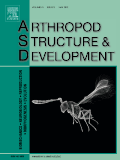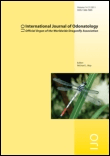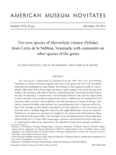
ARTHROPOD STRUCTURE & DEVELOPMENT
Scope & Guideline
Connecting Ecology and Arthropod Science
Introduction
Aims and Scopes
- Morphological and Anatomical Studies:
The journal prioritizes research that investigates the morphology and anatomy of various arthropods, including their external and internal structures, sensory organs, reproductive systems, and developmental stages. - Functional Morphology:
Papers often delve into the functional aspects of morphology, exploring how structural features relate to the ecological roles and behavioral functions of arthropods. - Comparative Analyses:
The journal encourages comparative studies that highlight evolutionary relationships among arthropod taxa, facilitating a better understanding of morphological adaptations across different environments. - Ultrastructural Investigations:
Research focusing on ultrastructural aspects using advanced imaging techniques is a significant component, providing detailed insights into the microscopic features of arthropods. - Developmental Biology:
The journal includes studies that examine developmental processes in arthropods, shedding light on ontogeny and the evolution of morphological traits.
Trending and Emerging
- Integrative Morphological Approaches:
There is a growing trend towards integrative studies that combine morphology with molecular techniques, providing a holistic view of arthropod structure and function. - Microstructural and Ultrastructural Research:
Recent papers increasingly focus on the ultrastructure of tissues and organs, utilizing advanced imaging techniques such as electron microscopy to reveal new insights into arthropod anatomy. - Evolutionary Developmental Biology (Evo-Devo):
The intersection of evolutionary biology and developmental studies is becoming more prominent, with research exploring how developmental processes influence morphological evolution in arthropods. - Sensory Biology:
Studies examining the morphology and function of sensory organs, particularly in relation to ecological adaptations, are on the rise, highlighting the importance of sensory mechanisms in arthropod survival and behavior. - Genomic and Genetic Investigations:
Research incorporating genomic data to understand morphological traits and evolutionary relationships is increasingly common, reflecting a broader trend in biology towards the integration of genetic information.
Declining or Waning
- Behavioral Morphology:
Research directly linking morphology to specific behaviors has become less frequent, suggesting a shift towards more structural and genetic studies rather than those that combine morphology with behavioral ecology. - Paleontological Morphological Studies:
Although studies on fossil arthropods have been integral to understanding evolutionary history, recent publications indicate a waning focus on paleontological aspects, possibly due to the increasing interest in molecular and developmental biology. - General Taxonomic Descriptions:
There is a noticeable decline in papers solely focused on taxonomic descriptions without accompanying morphological or functional analysis, reflecting a trend towards more integrative approaches to taxonomy.
Similar Journals

INTERNATIONAL JOURNAL OF ODONATOLOGY
Advancing Research in Dragonfly and Damselfly EcologyINTERNATIONAL JOURNAL OF ODONATOLOGY, published by Wachholtz Verlag GmbH, is a vital resource for researchers and professionals in the fields of Ecology, Evolution, Behavior, and Insect Science. Established in 1998, this journal provides a platform for the dissemination of innovative research pertaining to odonatology, encompassing the ecological and biological interactions of dragonflies and damselflies. With its focus on advancing knowledge within these scientific disciplines, the journal holds a commendable Q3 ranking in Ecology, Evolution, Behavior and Systematics and a Q2 ranking in Insect Science for 2023, reflecting its significance in academic circles. Although it operates without open access, its articles are accessible through institutional subscriptions, allowing for wide dissemination among scholars and practitioners. The journal's commitment to publishing high-quality, peer-reviewed research makes it an authoritative source of information that enriches the study of odonates and their broader ecological contexts. For inquiries, the journal's editorial team can be reached at C/O Fleet7, Fleethorn 7, Kiel 24103, Germany.

EvoDevo
Pioneering Insights in Evolution, Development, and BeyondEvoDevo, published by BMC, is a premier open-access journal dedicated to the fields of Developmental Biology, Ecology, Evolution, Behavior and Systematics, and Genetics. With an impressive Q1 ranking in its category for 2023, EvoDevo stands out as a significant resource for researchers, professionals, and students seeking to explore the intricate relationships between evolutionary processes and developmental mechanisms. Since its inception in 2010, this UK-based journal has provided a platform for innovative research and insights, boasting rigorous peer-review standards that ensure high-quality publications. With the E-ISSN of 2041-9139 and a commitment to freely accessible research, EvoDevo is positioned at the forefront of scientific discourse, making vital contributions to our understanding of biological complexities. As the journal converges years from 2010 to 2024, it serves as a cornerstone for knowledge dissemination, inspiring future research trajectories in evolutionary developmental biology.

JOURNAL OF MOLECULAR EVOLUTION
Fostering Knowledge in Molecular Evolutionary ScienceThe Journal of Molecular Evolution, published by Springer, is a prestigious peer-reviewed journal dedicated to advancing the understanding of molecular evolution through high-quality research and analysis. With an impact factor establishing it as a leading authority in the field, this journal provides a vital platform for scholars focused on the intricate relationships between molecular biology and evolutionary processes. Featuring a Q1 ranking in Ecology, Evolution, Behavior and Systematics, and significant rankings in Genetics and Molecular Biology, the journal has consistently positioned itself at the forefront of academic discourse since its inception in 1971. Notably, the journal boasts an extensive archive that converges from 1971 to 2024, providing a comprehensive resource for current and future research. Although it operates on a subscription model, the high caliber of contributions ensures that it remains an essential reference point for researchers, professionals, and advanced students eager to deepen their understanding of molecular mechanisms and evolutionary dynamics.

BMC Zoology
Unlocking the mysteries of the animal kingdom.BMC Zoology, published by BMC, is a distinguished open-access journal that has been advancing the field of zoological research since its inception in 2016. With an impressive Q2 ranking in both Animal Science and Zoology categories as of 2023, the journal occupies a significant position in the academic landscape, engaging a global readership dedicated to the exploration of animal biology. Based in the United Kingdom, BMC Zoology prides itself on providing a platform for innovative research, fostering collaboration among scientists, and facilitating access to high-quality scholarly articles. Researchers and practitioners in zoology can benefit from its extensive repository of articles that span various areas including conservation, ecology, and evolutionary biology. As an essential resource for scholars and students alike, BMC Zoology commits to enhancing the dissemination of knowledge in the zoological sciences through its open-access model, ensuring widespread access to cutting-edge research findings.

JOURNAL OF MAMMALIAN EVOLUTION
Exploring Evolutionary Pathways of MammalsJOURNAL OF MAMMALIAN EVOLUTION, published by SPRINGER, stands at the forefront of the field of mammalian evolutionary research since its inception in 1993. Renowned for its scholarly rigor, this journal covers an extensive range of topics within ecology, evolution, behavior, and systematics, achieving a prestigious Q1 rank in its category, according to the latest metrics. With an ISSN of 1064-7554 and E-ISSN of 1573-7055, it offers critical insights into the diverse adaptations and evolutionary processes of mammals, making it an invaluable resource for researchers, professionals, and students alike. The journal maintains a significant impact factor, reflecting its relevance in shaping current discourse and discoveries within the biological sciences, particularly in mammalogy. Access to its rich repository of articles aids in fostering scientific collaborations and advancing knowledge in the evolutionary sciences, thus solidifying its role as a critical platform for cutting-edge research.

ZOOMORPHOLOGY
Illuminating the connections between structure and survival.ZOOMORPHOLOGY, published by SPRINGER, stands as a pivotal journal in the fields of Animal Science, Zoology, and Developmental Biology. Since its inception in 1980, this journal has been dedicated to advancing the understanding of animal morphology and the evolutionary adaptations of various species. With an ISSN of 0720-213X and an E-ISSN of 1432-234X, ZOOMORPHOLOGY boasts a Q2 ranking in Animal Science and Zoology and is recognized within the Q4 category in Developmental Biology as of 2023, reflecting its impactful contributions to the scientific community. The journal is indexed in Scopus, where it ranks #224 out of 490 in Animal Science and Zoology, and #66 out of 82 in Developmental Biology, positioning it as a resource of considerable significance for researchers and professionals in these disciplines. Although ZOOMORPHOLOGY currently operates on a traditional access model, it continues to foster scholarly communication and inspire future researchers through rigorous peer-reviewed articles that explore the intricate relationships between form and function in the animal kingdom. With a commitment to excellence and innovation, ZOOMORPHOLOGY remains a vital platform for publishing high-quality research that drives forward our knowledge in morphology and evolutionary biology.

INTERNATIONAL JOURNAL OF MORPHOLOGY
Advancing Knowledge in Morphological ScienceThe INTERNATIONAL JOURNAL OF MORPHOLOGY is a distinguished publication dedicated to the field of anatomy, significantly contributing to the scholarly discourse within this essential area of medical science. Published by the SOC CHILENA ANATOMIA and located in Chile, this journal aims to disseminate groundbreaking research that explores the structural aspects of organisms, from comparative anatomy to developmental processes. With an H-index reflecting its growing impact, the journal has achieved a Q3 ranking in the category of Anatomy according to the 2023 metrics, positioning it among the competitive resources available to the scientific community. Researchers and professionals engaging with this journal can expect to encounter rigorous studies, insightful reviews, and innovative methodologies. Though not strictly open access, the journal remains pivotal for those keen on advancing their understanding of morphological structures and their implications in various fields. With convergence ongoing from 2006 to 2024, the INTERNATIONAL JOURNAL OF MORPHOLOGY is poised to further solidify its role as a vital source of knowledge for anatomy enthusiasts and experts alike.

AMERICAN MUSEUM NOVITATES
Pioneering Research at the Intersection of Science and Culture.AMERICAN MUSEUM NOVITATES, published by the American Museum of Natural History, stands as a prestigious platform for scholarly dissemination in the fields of Archeology, History, and Museology. With an impressive impact factor evidenced by its Q1 rankings in 2023 across these categories, this journal is a vital resource for researchers and professionals seeking to advance knowledge and understanding within these disciplines. The journal's commitment to quality research is reflected in its high rankings within Scopus, where it boasts a remarkable rank of #37 in History and #4 in Museology, showcasing its relevance and influence in the academic community. While open access options are not currently available, readers can access compelling research articles that span from its inception in 2005 to the present date, making it an essential reference for those interested in the historical and cultural implications of natural history and museum studies. Located in the heart of New York, this journal fosters a collaboration between scientists and scholars, enriching both academic and public understanding of our shared heritage.

Open Biology
Exploring the depths of life sciences with global insights.Open Biology is a prestigious, interdisciplinary journal published by the Royal Society that has been paving the way in the fields of Biochemistry, Genetics and Molecular Biology, Immunology, and Neuroscience since its inception in 2011. Catering to a global audience of researchers, professionals, and students, Open Biology operates under an open access model, facilitating the unrestricted dissemination of high-quality research findings. With a current impact factor that positions its categories in the top quartile (Q1) and impressive Scopus rankings—evidencing its influence and reach—this journal serves as a vital platform for innovators and scientific inquiries aimed at advancing our understanding of life sciences. The journal's commitment to publishing cutting-edge research makes it an essential resource for those at the forefront of scientific exploration.

Russian Journal of Developmental Biology
Illuminating the pathways of biological growth.The Russian Journal of Developmental Biology, published by PLEIADES PUBLISHING INC, serves as a significant platform for researchers and professionals engaged in the field of developmental biology. With the ISSN 1062-3604 and E-ISSN 1608-3326, this journal focused on intricate biological processes and dynamic developmental mechanisms from 2005 until 2017. Although its coverage is currently discontinued in Scopus, it remains notable for its contribution to understanding the pivotal roles of biochemistry and molecular genetics within the context of development. As a publication situated in the competitive quartiles of the field and boasting an influential Scopus rank of #77 out of #78, it has made a unique mark in developmental studies. Researchers and academics seeking to enhance their knowledge of historical advancements in the discipline will find the journal a valuable resource, even as it navigates the transition away from active publication.